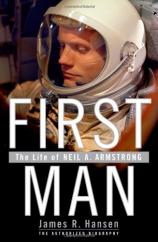First Man: The Life of Neil A. Armstrong
Review
First Man: The Life of Neil A. Armstrong
Sometimes biography, like space exploration, can be a hazardous occupation. The intrepid biographer who tackles a subject as famous --- yet at the same time as personally unknowable --- as Neil Armstrong has a difficult job indeed on his hands.
James R. Hansen, a history professor at Auburn University and a former NASA historian, has tried in this book to get at his subject by unearthing every possible detail of his life, no matter how trivial, and spilling the whole accumulation onto his pages --- 648 of them and another 60-plus pages of notes and a vast bibliography. It is a valiant effort, but is only intermittently successful.
Neil Armstrong became world famous in late July of 1969 when the space capsule he commanded made it successfully to the moon and back. Of all the astronauts from that day to this, he and his two companions, Edwin E. Aldrin and Michael Collins, are the only ones known today to people who are not space buffs or aviation enthusiasts.
Armstrong's co-workers consistently found him a "loner," a man with "no ego... laconic...unemotional...thoughtful...different than other people."
The conscientious Hansen interviewed Armstrong for over 50 hours, tracked down virtually anyone else who had even a peripheral effect on his life, burrowed through a mountain of documents, and doubtless drew on his own inside knowledge of NASA. Yet the end result is a mountain of detail rather than a consistently insightful and interesting book. He stresses that though his work is an "authorized" biography, Armstrong himself checked it only for factual accuracy, not for its conclusions about those facts. Fair enough. There is no evidence in the book of outside tampering; in fact Hansen has some critical things to say about NASA, his old employer, and about some of Armstrong's colleagues.
The Apollo 11 moon mission itself occupies only about a quarter of the book. Here the text at last comes to life, but mainly because of the unprecedented hazards that the trip presented. No one who lived through those four or five days can ever forget them. They do live again in these pages, but pretty much in spite of Hansen's drily documentary prose.
The rest of FIRST MAN is a mass of facts, their flow clogged by masses of technical detail, space-speak acronyms and digressive asides. We learn what music was played at Armstrong's mother's wedding; we find out all his college grades at Purdue; we learn the maiden names of the wives of all his astronaut colleagues; we get a list of everyone who accompanied him on a goodwill tour of South America; we learn exactly how many words were uttered by each of the three astronauts in their opening statements at a pre-launch press conference. Hansen, listed as the author of eight previous books, has allowed his historian's lust for detail to trump his writer's instinct for smoothness and narrative flow.
He is at pains to correct various legends and false impressions that have accumulated around Armstrong over the years. Madalyn Murray O'Hair insisted that he was an atheist, for example; and after his return from the moon there was a story that he had converted to Islam.
Other recurrent themes in the book include the suspicion and distrust of the press that Armstrong shared with most of his fellow astronauts, the frenzy of public adulation that overwhelmed him after the moon mission (and contributed to the breakup of his 38-year marriage) and the inside-baseball politics of the NASA bureaucracy itself.
The mystery concerning the origin of the words he spoke when he first stepped on the moon ("One small step for man...." etc.) is explored in detail. A different quote, one that seems better to convey the kind of man he was, however, is the laconic remark he uttered when the lunar lander touched down safely at the Sea of Tranquility: "So far, so good." A man of few words indeed!
There is a vast amount of information in this book that may well be of great interest to aeronautical engineers and aviation buffs, but will have little appeal to the general reader seeking to know Neil Armstrong. He remains, in the words of one observer, "very tight emotionally," and Hansen has not really unlocked him.
Reviewed by Robert Finn (Robertfinn@aol.com) on January 22, 2011
First Man: The Life of Neil A. Armstrong
- Publication Date: October 18, 2005
- Genres: Biography, Nonfiction
- Hardcover: 784 pages
- Publisher: Simon & Schuster
- ISBN-10: 074325631X
- ISBN-13: 9780743256315




